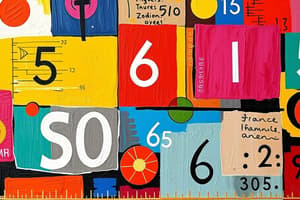Podcast
Questions and Answers
How many significant figures are in the measurement 0.000456 meters?
How many significant figures are in the measurement 0.000456 meters?
- 5
- 4
- 3 (correct)
- 6
Which of the following statements about nonzero integers is accurate?
Which of the following statements about nonzero integers is accurate?
- Nonzero integers are often significant
- Nonzero integers are always significant (correct)
- Nonzero integers are sometimes significant
- Nonzero integers are never significant
In the number 10,068 feet, how many significant figures are present?
In the number 10,068 feet, how many significant figures are present?
- 4 (correct)
- 5
- 3
- 2
Which statement about exact numbers from counting is true?
Which statement about exact numbers from counting is true?
Why is measurement considered one of the most important scientific activities?
Why is measurement considered one of the most important scientific activities?
Who predominantly uses the metric system?
Who predominantly uses the metric system?
What is the primary reason for understanding the SI system of measurement?
What is the primary reason for understanding the SI system of measurement?
Which of the following numbers is NOT used for conversions in the American Standard system?
Which of the following numbers is NOT used for conversions in the American Standard system?
Identify the incorrect basic SI conversion.
Identify the incorrect basic SI conversion.
What does the prefix in an SI unit indicate?
What does the prefix in an SI unit indicate?
When converting from smaller units to larger units, what should be done?
When converting from smaller units to larger units, what should be done?
When moving the decimal point in a measurement conversion, what does each space represent?
When moving the decimal point in a measurement conversion, what does each space represent?
Flashcards
Significant Figures
Significant Figures
The digits in a measurement that are considered reliable and contribute to its precision. They indicate the level of accuracy of a measurement.
How many significant figures?
How many significant figures?
To determine the number of significant figures in a measurement, follow these rules:
- Nonzero digits are always significant.
- Zeros between nonzero digits are always significant.
- Leading zeros (zeros before the first nonzero digit) are never significant.
- Trailing zeros (zeros after the last nonzero digit) are significant only if a decimal point is present in the number.
Rounding off Significant Figures
Rounding off Significant Figures
To round off a number to a specified number of significant figures, look at the digit to the right of the last significant figure. If it's 5 or greater, round the last significant digit up. If it's less than 5, leave the last significant digit as it is.
Exact Numbers in Significant Figures
Exact Numbers in Significant Figures
Signup and view all the flashcards
Why is measurement important in science?
Why is measurement important in science?
Signup and view all the flashcards
Who uses the metric system?
Who uses the metric system?
Signup and view all the flashcards
Why is understanding the SI system important?
Why is understanding the SI system important?
Signup and view all the flashcards
SI Conversions
SI Conversions
Signup and view all the flashcards
Prefixes in the SI system.
Prefixes in the SI system.
Signup and view all the flashcards
Converting from smaller to larger units
Converting from smaller to larger units
Signup and view all the flashcards
Converting from larger to smaller units
Converting from larger to smaller units
Signup and view all the flashcards
Decimal movement in conversions
Decimal movement in conversions
Signup and view all the flashcards
Study Notes
Measurement in Science
- Measurement, specifically the collection of accurate quantitative data, is crucial in science.
- The metric system (SI) is used globally by scientists and educators.
- Understanding SI units is important because most of the world uses them.
SI System
- The SI system is based on units of ten, simplifying conversions.
- Prefixes modify the base unit, indicating the multiple or fraction of that unit.
- Converting from a smaller to a larger unit involves division by a factor of 10.
- Converting from a larger to a smaller unit involves multiplication by a factor of 10.
- Each decimal place shift represents a factor of 10.
Significant Figures
- Significant figures represent the certain and estimated digits in a measurement.
- Non-zero integers are always significant.
- Zeros are significant only when they are between non-zero digits or at the end of a decimal number.
- Exact numbers (from counting or definitions) have an infinite number of significant figures.
- Rounding to a specific number of significant figures follows specific rules, including the "rounding up" rule.
Significant Figures Examples
- 1.23 cm has 3 significant figures.
- 10,068 feet has 5 significant figures.
- 0.000456 meters has 3 significant figures.
- Trailing zeros in a decimal number are significant.
Density
- Density is a ratio of mass to volume.
- Density is measured in units like grams per cubic centimeter (g/cm³) or grams per milliliter (g/mL).
- Density is an intrinsic property of a substance.
Conversions
-
1 mL of water has a mass of 1 gram.
-
Common American conversions (like 5280 feet in a mile) are not SI units.
-
Metric conversion examples:
- 10 dm = 1 m
- 10 cm = 1 dm
- 10 mm = 1 cm
-
9.22 m = 9220 mm
-
2000 mm = 0.002 km
Studying That Suits You
Use AI to generate personalized quizzes and flashcards to suit your learning preferences.
Description
This quiz covers the important concepts of measurement in science, focusing on the SI system and the significance of significant figures. Understand how to use the metric system effectively, including conversions and the importance of accuracy in scientific data collection.




